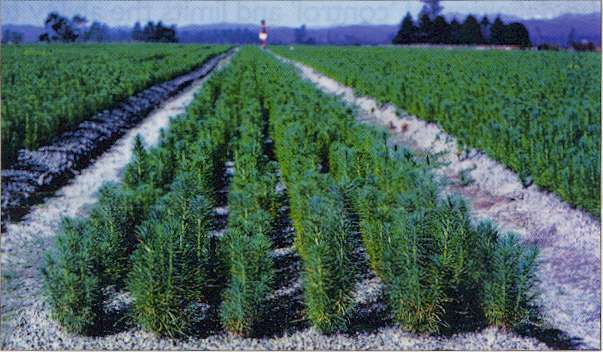Quality Upgrades for the Future
Some Investment Advisers Are Questioning the Value of ForestryI like trees because they seem more resigned to the way they have to live than other things do. - Willa Cather
Fast Growers: Today's Trees Grow Up to 30% Faster than Earlier Varieties Timber Quality Upgrades Guarantee Future Marketby Roger Dickie Now that the hype of the 1993/94 long price peak is well past, some financial commentators and investment advisers are questioning the value of investment in radiata forestry. The Asian crisis and the dramatic fall in demand for our low value logs from Korea has added to their concern. In fact, if investors and their advisers examine the industry more closely they will see that the financial fundamentals supporting forestry investment today are still strong. The radiata forests being planted today are significantly different to most of those being harvested today. The majority of forests being harvested now are unpruned and grown from unimproved tree stocks, many of them are planted on poor sites unwanted by sheep and beef farmers of the 1950s and 1960s. Radiata pine being planted now has been genetically improved over 75 years by the best forest research institution in the world (FRI, Rotorua). The trees we plant today grow faster (up to 30%) and produce more volume of high value wood in a shorter time than their great-grandparents". Forest owners can now compete with livestock farmers to select the most fertile sites and apply modern forest management techniques to increase the yield of high value pruned wood per hectare. In pruned forests being harvested today this high value wood is providing 66% of the net return from the forest after payment of all harvest costs. Investors today are focusing on the high value quality end of the wood market, not the lower value log traditionally sold to Korea. Our own forest managers provide further proof of the financial sense of this move. Part of a forest they planted in 1972, and pruned, was harvested before the Asian crisis in 1997, and the balance harvested recently. The net log price they received fell by only I% despite the crisis in Asia. This is because demand and price for our pruned logs remains strong. Historically, demand for industrial (high value) wood rises with population growth and improved socio-economic standards. World population growth and GDP rise are forecast to continue. On the supply side over-cutting of indigenous forests, political and environmental pressures are steadily reducing wood supply options. In the past year, 16 million ha of world forest was destroyed; 60,000 sq km (an area twice the size of Belgium) of the Amazon rainforest was slashed, burnt and cleared between 1995 and 1997. A well-managed radiata forest can produce over 700 tonnes of useable wood per hectare in 28 years; most indigenous forests yield around 150 tonnes per hectare. Wood is a most versatile fibre that can be made into 250 products. A growing radiata forest is an environmentally-friendly, perpetually renewable carbon sink. Wood substitutes on the other hand such as steel, concrete and plastic require large amounts of energy, produce carbon during manufacture and are environmentally unfriendly. Even at today's prices a well-managed radiata forest can show a compound return of around 9% per annum. World wood prices have traditionally increased ahead of inflation and there is no reason to suggest this will not continue. A radiata forest fits well in a balanced investment portfolio because: It is profitable:
The best returns for forestry investors come to those who either hold the trees through to harvest or, at least until pruning and thinning is complete. Leading forestry promoters operate structures that have large blocks of forest in one area on fertile sites, close to export ports with a strong foundation to build profitable marketing structures in the future. Secondary markets are operated to allow investors to sell their forests before harvest. While there is an element of risk in all investment, critics will have little success in finding a dissatisfied forestry investor who is harvesting a pruned radiata forestry today. Roger Dickie is the principal of Roger Dickie (New Zealand) Ltd, a forestry investment developer Source: The National Business Review 17 July 1998
I wonder if the 9% compound return per annum is before, or after, Manager fees are subtracted? He could find a number of dissatisfied forestry investors who should be harvesting a pruned radiata forest today, but aren't. Further, the faster-growing trees haven't proven to be as dense. Lumber made from those trees warps more easily.
For news articles on the Flat Rock Forests Trust, forestry, the Serious Fraud Office, one immigrant family's experiences, immigration
specialists, fraud, juries, logging, and more, pressing the "Up" key below will take you to the Table of Contents for this News
section. Or you may wish to visit the Forestry Trust Table of Contents to read how a unit
trust went bust. Or the Topics Table of Contents which offers a different
approach to lots of topics - among them poisonous insects, eating dogs, what's addictive, training vs teaching, tornados, unusual flying
machines, humour, wearable computers, IQ tests, health, Y chromosomes, share options, New Jersey's positive side, oddities, ageing,
burial alternatives, capital punishment, affairs, poverty, McCarthyism, the most beautiful city in the world, neverending work and
more... |
 Animals
Animals Animation
Animation Art of Playing Cards
Art of Playing Cards Drugs
Drugs Education
Education Environment
Environment Flying
Flying History
History Humour
Humour Immigration
Immigration Info/Tech
Info/Tech Intellectual/Entertaining
Intellectual/Entertaining Lifestyles
Lifestyles Men
Men Money/Politics/Law
Money/Politics/Law New Jersey
New Jersey Odds and Oddities
Odds and Oddities Older & Under
Older & Under Photography
Photography Prisons
Prisons Relationships
Relationships Science
Science Social/Cultural
Social/Cultural Terrorism
Terrorism Wellington
Wellington Working
Working Zero Return Investment
Zero Return Investment